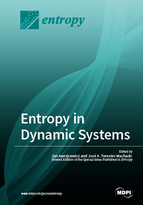Entropy in Dynamic Systems
A special issue of Entropy (ISSN 1099-4300).
Deadline for manuscript submissions: closed (30 September 2018) | Viewed by 39109
Special Issue Editors
Interests: nonlinear dynamics; non-linear mechanics; control; biomechanics; mechatronics
Special Issues, Collections and Topics in MDPI journals
Interests: nonlinear dynamics; fractional calculus; modeling; control; evolutionary computing; genomics; robotics, complex systems
Special Issues, Collections and Topics in MDPI journals
Special Issue Information
Dear Colleagues,
In order to measure and quantify the complex behavior of real-world systems, either novel mathematical approaches or modifications of classical ones are required to precisely predict, monitor and control complicated chaotic and stochastic processes governed by difference and differential (ordinary and partial) equations, algebraic-differential equations, integral-differential equations and equations with time delay. Though the roots of dynamical entropy are associated with the names of influential mathematicians, such as Kolmogrov, Sinai, Shannon, Krieger, Orstein, and Dinsburg, nowadays, it wandered to different branches of pure and applied sciences, and it possesses various meanings.
Multiple meanings of entropy is exhibited in physics and engineering, where it refers to the first and second thermodynamics laws and the Shannon and Boltzman entropies (in probabilistic theory and statistical mechanics), dynamical entropy (mathematics and applied mathematics, physics, economy, history, biology, social sciences, immunological systems), topological entropy (including information about the system evolutions), symbolic extension entropy (it allows for controlling the data compression based on entropy structure), digitalization entropy, etc.
Though the term of entropy came from Greek and emphasizes its analogy to energy, its multiple meanings in numerous branches of sciences are understood in a rather rough way, with an emphasis on transition from regular to chaotic states, stochastic and deterministic disorder, uniform and non-uniform distribution or decay of diversity.
This Special Issue addresses the notion of entropy in its broader sense and hence the manuscripts from different branches of mathematical/physical sciences, natural/social sciences and engineering oriented sciences are invited putting emphasis on complexity of dynamical systems including the features like timing chaos and spatio-temporal chaos, bifurcation, synchronization and anti-synchronization, stability, lumped mass and continuous mechanical systems modeling, novel non-linear phenomena, resonances, and beyond.
This Special Issue aims at covering diverse research from qualitatively different sciences, linked by dynamical entropy phenomena, understood in a broad manner. In particular, the following topics are of interest:
- Complex analysis of difference and differential equations;
- Dynamics and control of complex engineering systems;
- Advances in fractional calculus;
- Mathematical modelling of entropy in classical and generalized dynamical systems;
- Entropy in physics, applied mathematics and information theory;
- Entropy-based approaches to study transportation, social, financial and economical networks;
- Deterministic chaotic versus stochastic processes;
- Vibration signal processing and complex dynamics;
- Entropy, Lyapunov exponents, Fourier and wavelet transforms and dimension;
- Local, metric, topological, symbolic extension and smooth/non-smooth dynamical entropy.
Prof. Dr. Jose A.T. Machado
Guest Editors
Manuscript Submission Information
Manuscripts should be submitted online at www.mdpi.com by registering and logging in to this website. Once you are registered, click here to go to the submission form. Manuscripts can be submitted until the deadline. All submissions that pass pre-check are peer-reviewed. Accepted papers will be published continuously in the journal (as soon as accepted) and will be listed together on the special issue website. Research articles, review articles as well as short communications are invited. For planned papers, a title and short abstract (about 100 words) can be sent to the Editorial Office for announcement on this website.
Submitted manuscripts should not have been published previously, nor be under consideration for publication elsewhere (except conference proceedings papers). All manuscripts are thoroughly refereed through a single-blind peer-review process. A guide for authors and other relevant information for submission of manuscripts is available on the Instructions for Authors page. Entropy is an international peer-reviewed open access monthly journal published by MDPI.
Please visit the Instructions for Authors page before submitting a manuscript. The Article Processing Charge (APC) for publication in this open access journal is 2600 CHF (Swiss Francs). Submitted papers should be well formatted and use good English. Authors may use MDPI's English editing service prior to publication or during author revisions.
Related Special Issue
- Entropy in Dynamic Systems II in Entropy (5 articles)








